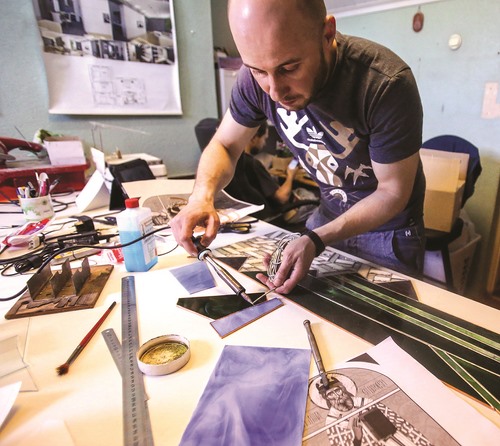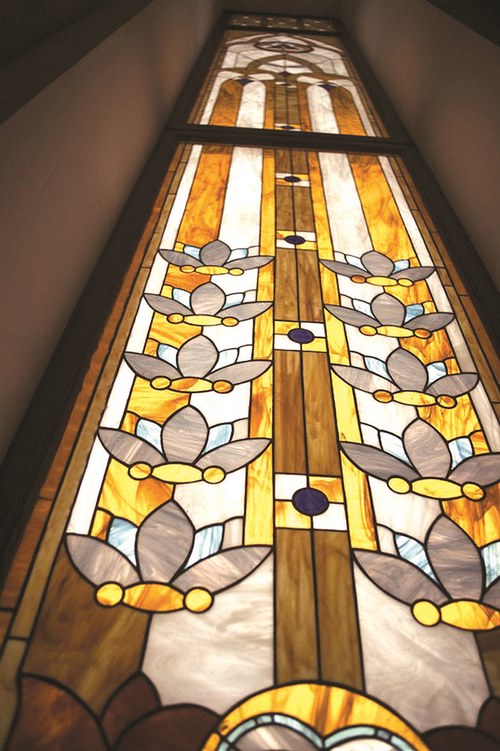People tend to say that stained glass evokes a special atmosphere, inspiring an emotional response, and spiritual calm. The art form is back in vogue, being used by modern designers to transform and beautify interior spaces, within windows and doors, ceilings, partitions, folding screens, furniture and lamps… “It can even help create zones within a space,” says Alexey Losik, a monumental artist who has been working with stained glass for the past ten years.

Stained glass designer Alexey Losik
Mr. Losik’s studio features an unfinished piece on the table; dark green, grey, black and white glass fragments are scattered on the worktop. When lifted to the light, they change in appearance, being destined to become part of an artwork in stained glass. The artist shows us a sketch and explains the fundamentals; he makes a preliminary design on the computer, which he magnifies to full size and prints out, for use as a pattern. Each element of stained glass is then cut manually.
He first tried working with glass as a 3rd year student with the Belarusian State Art Academy’s Artistic Department. He studied the technology of classical stained glass making, with lead H-shaped profiles, as used to make gothic stained glass windows in the Middle Ages. This technique, however, does not allow the easy combination of small pieces, unlike the tiffany method, named after its creator, Louis Comfort Tiffany, son of the owner of the Tiffany and Co jewellery empire.
“He replaced lead profiles with copper strings,” Alexey explains. ”They’d be attached to glass with the help of beeswax and then soldered using tin.” The technology was so progressive that the art of stained glass artworks began to develop in two and three dimensions.

Samples of completed work
Mr. Losik adds, “Many contemporary masters who use the tiffany technique purchase American glass. Our country doesn’t produce such glass, which is available in over 2,000 tints. I remember, once, searching for a ‘crushed blueberry’ colour. If you add various graphic and texture patterns, billions of variants are possible.”
He cuts the glass easily with an oil glass-cutter, as if it were paper. Then, he polishes the edges with a special machine (no more than a 2-millimetre error is permissible), before encasing them in brass foil and laying them out on the table.
I wonder how often he cuts himself but he asserts that it’s rare, once you’ve been working with the equipment for a while. “Soldering is the most difficult process, as you have turn the fragile item over half way through, which is rather tricky. Although we use tin and lead soldering alloy, with minimum content of harmful metal, we still have to wear respirators; it’s especially uncomfortable in hot weather.”
He covers the thin string, and it instantly hardens with a patina, oxidising to give brilliance and lovely colorations, in shades of brown through to black. It provides an additional artistic effect.
I ask if he studied cutting and soldering at university and he tells me that he didn’t, rather mastering these skills in the workshop. He notes, “Women tend to be better at work like this, it being related to creating cosy home interiors. What you do need to learn is how to create the right composition, so that all elements are of proper size and fit into the chosen space.”
Techniques of making stained glass designs depend on the complexity and size of the work. For example, a simple design covering an area of one square metre may be finished within three days. Meanwhile, the artist’s workshop took almost six months to complete the 120sq.m, 11,000-piece stained glass work for the ceiling of the Bolshoi Opera and Ballet Theatre. Major projects, like this, are transported to the site in sections, for assembly in situ, using various techniques to ensure that the fragile beauty of a piece is kept safe.

“If we find, once a work is in place, that a piece doesn’t match, we take the whole work out of its frame to remove the piece and replace it with another. Sometimes it seems that it’s easier to redo the whole thing,” Alexey tells us. Fortunately, this doesn’t happen often. However, it’s best to ensure that every detail is thoroughly thought-out during the design stage, taking into consideration lighting and the style of the premises, as well as the mood sought, since stained glass works are always centrepieces, more so even than paintings.
It’s a shame that they’re so expensive to produce, but Alexey tells us that film (or pseudo) stained glass works are cheaper to make. In this case, colourful film pieces and solder-imitating strings are attached to a sheet of glass. It seems a strange method but he adds, “Of course, this is much cheaper than a tiffany, but the difference is like that between a piece of glass and a diamond. The light effects are totally different.”
Not only owners of mansions and elite urban apartments order exquisite stained glass works by modern artists. If you look, you’ll see them in cafes, hotels, theatres and holy buildings, with themes ranging from the biblical to light geometrical ornamentation.
Mr. Losik adds, “We may soon receive an order for Slutsk belt-styled stained glass works,” although he won’t reveal the customer’s name. “We’re supposed to not just imitate the pattern, but to stylise it, making it contemporary yet authentic-looking. It will be a very interesting job. I also want to make stained glass works for ancient Belarusian architectural buildings, to show that our culture and heritage goes beyond material things. Stained glass can be perceived in various ways. Some treat it merely as glass but I think that the way light is deflected through its texture gives it other qualities.”
A stained glass work may endure 100 years, or even 500. Over time, glass melts and moves, so that it becomes thinner in upper sections, and thicker in others, like a candle’s wax. Alexey is delighted to think of his works enduring, saying, “This is not just a job to earn money, but a vocation for me. I want my stained glass works to have an emotional impact on people, to inspire and encourage them to think, and to create a certain mood.”
By Nadezhda Dekola











